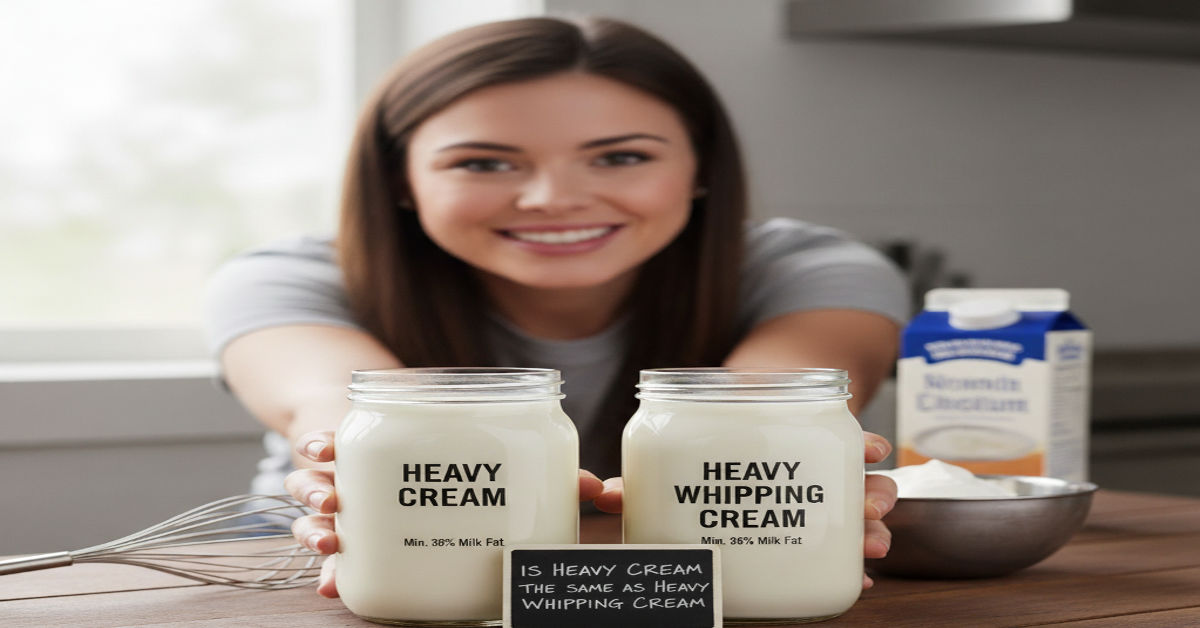When you stroll down the dairy aisle, you’ll often spot cartons labelled heavy cream alongside those marked heavy whipping cream. At first glance they may appear identical but for chefs, bakers and home cooks alike, understanding whether they are truly the same—and how their subtle differences impact cooking—can elevate your results. In this article we will walk through definitions, standards, practical usage in the kitchen and substitution guidelines so you can shop, cook and bake with confidence.
We’ll dig into the regulatory definitions that govern these terms, clarify common misconceptions, and provide tables of useful side-by-side comparisons. Whether you are making a velvety sauce, whipping dessert topping or simply want to know what to buy, you’ll finish with clarity and practical knowledge.
What is heavy cream?
Heavy cream is essentially the rich fatty layer skimmed from whole milk. In production, once milk is separated, the cream portion (higher in milk fat) is collected and normally standardized, pasteurized or ultra-pasteurized and homogenized to produce a consistent product. The reason it matters in cooking is that the fat content gives it body, richness and stability that lower-fat creams lack. In sauces, soups, custards and desserts this added fat ensures smoother texture and less risk of separation.
In the United States, the term heavy cream carries a regulatory definition: the food product must contain at least 36 percent milk fat. This threshold sets it apart from lighter cream variants. With that level of fat you can expect heavy cream to whip into firm peaks, coat ingredients smoothly, and hold shape under moderate heat. This makes it a versatile tool in both sweet and savoury applications.
What is heavy whipping cream?
Heavy whipping cream is a label commonly used in retail that often corresponds to the same classification as heavy cream—meaning a milk fat content of at least 36 percent. In many cases, heavy whipping cream and heavy cream are interchangeable in terms of definition, especially under U.S. regulations. The name “heavy whipping cream” emphasises its utility for whipping—making whipped toppings, frostings and decorative piping.
However, it is important to distinguish heavy whipping cream from standard “whipping cream” (or “light whipping cream”). The latter typically has a slightly lower fat content—often in the 30 percent to 36 percent range. That lower fat means less body, softer peaks when whipped, and somewhat less stability for high-structure applications. Thus, when you see heavy whipping cream, you are usually getting the higher-fat version, but when you see “whipping cream” alone you may be dealing with a slightly weaker product.
Regulatory definitions and fat-content standards
Regulatory definitions anchor usage of dairy product names so manufacturers and consumers know what they’re getting. In the U.S., the Code of Federal Regulations states:
“Heavy cream is cream which contains not less than 36 percent milkfat.”
This is a clear minimum threshold. Many commercial heavy creams hover around 36 percent to 40 percent milk fat. Meanwhile, typical “whipping cream” in many grocery stores may fall into the 30 percent to 36 percent milk-fat range.
Here is a table summarizing fat-content standards by category in the U.S.:
| Product Label | Minimum Milk-Fat % | Typical Use |
| Heavy cream / heavy whipping cream | ≥ 36 % | Rich sauces, firm whipped toppings, high-heat uses |
| Whipping cream (or light whipping cream) | 30 % – 36 % | Airy toppings, lighter texture desserts |
| Light cream / table cream | 18 % – 30 % | Coffee cream, mild sauces |
| Half-and-half | 10.5 % – 18 % | Coffee, mild enrichment of dishes |
These definitions help clarify what you’re purchasing and inform how the product will behave in your recipe.
Practical differences in cooking and baking
Although heavy cream and heavy whipping cream often refer to the same product (with fat ≥ 36 percent), subtle practical differences emerge in cooking or baking when you compare them with lower-fat creams. For example, when making a creamy pasta sauce or soup, the higher fat of heavy cream helps reduce the risk of curdling and gives a smoother mouth-feel. Because fat disperses heat differently and helps stabilize emulsions, heavy cream becomes the safer bet in dishes exposed to heat or acidity.
In desserts, the difference becomes even more noticeable. When you plan to whip cream into peaks for piping or layering, the fat content dictates how well air is trapped and how stable those peaks are over time. A high-fat cream (heavy/ heavy whipping) will whip faster and hold its structure versus a standard whipping cream with lesser fat. Therefore, although you might use them interchangeably in some circumstances, the choice can influence texture, thickness and stability.
Substitution rules and recipe impact
One of the most common questions is: if I only have one type of cream, can I use it instead? The short answer is yes in many cases—but not always without caveats. For general cooking tasks such as enriching soups or sauces, substituting a cream labelled heavy or heavy whipping cream (fat ≥ 36 percent) for another is usually fine. Similarly, you can often use a slightly lower-fat whipping cream in place of heavy cream—but you may notice differences in thickness or stability.
Here is a table outlining substitution guidance:
| Scenario | Suggested Approach | Impact on Recipe |
| Sauce or soup enrichment | Use heavy cream or heavy whipping cream (≥ 36 %) | Smooth texture, minimal curdling risk |
| Whipped topping requiring firm peaks | Use heavy or heavy whipping cream | Firm, stable peaks suitable for piping |
| Whipped topping for light dollop | Use standard whipping cream (30-36 %) | Softer peaks, less hold-time |
| Recipe calls for heavy cream, only light cream available | Combine whole milk + melted butter (see DIY section) | Slightly altered mouth-feel, less richness |
If you substitute a lower-fat cream for a high-structure dessert, expect softer texture, faster collapse of whipped peaks, or thinner sauces. On the flip side, using heavy cream when a lighter finish is acceptable will still work—and often will simply yield a richer end result. The key is to match your choice with the function required by the recipe.
Nutritional comparison: heavy cream vs heavy whipping cream
When it comes to nutrition, heavy cream and heavy whipping cream are very similar if they both meet the ≥ 36 percent milk-fat standard. The main difference is seen when contrasting with lower-fat whipping creams (30-36 percent) or lighter cream products. Here is a comparative table to illustrate:
| Product | Approx. Calories per Tbsp* | Approx. Total Fat | Carbohydrates | Protein |
| Heavy cream / heavy whipping (≥ 36 %) | ~ 51 kcal | ~ 5.4 g | ~ 0.4 g | ~ 0.4 g |
| Standard whipping cream (30-36 %) | ~ 44 kcal Healthline | ~ 4.6 g | ~ 0.4 g | ~ 0.3 g |
*Approximate values for a tablespoon (~15mL) of cream.
From a nutritional standpoint both are high in saturated fat and calories, so moderation is wise. The slightly higher fat in heavy/ heavy whipping cream gives marginally more richness but does not dramatically alter the nutritional profile. If you are following low-carb or ketogenic styles of eating, both creams are suitable due to minimal carbohydrates—though the calorie and saturated fat load remains significant.
Thus the takeaway is: choose based on cooking need rather than a large nutritional difference, since they behave and contribute similarly in most recipes.
Common uses in sweet and savoury dishes
The versatility of high-fat creams is what makes them indispensable in many culinary settings. On the sweet side you’ll find heavy cream or heavy whipping cream in whipped toppings, mousse, ganache, ice cream bases, and cake fillings. Because of their fat content and stabilisation capacity, they create luxurious textures that are both rich and resilient. For example, a chiffon cake’s filling often relies on a firm-whipped cream that doesn’t collapse under layers of sponge.
On the savoury side these creams play a major role in dishes like bisques, creamy pastas (Alfredo, carbonara), gratins, mashed potatoes, and hearty soups. The extra fat adds mouth-feel and helps prevent separation when heat is applied. When you want a sauce that is smooth and holds together, heavy cream is your ally.
Here’s a table summarizing uses by type of dish:
| Dish Type | Ideal Cream Type | Why It Works |
| Dessert piping/frosting | Heavy/Heavy Whipping (≥ 36 % fat) | Holds firm peaks required for decorative structure |
| Light dessert topping | Standard Whipping (30-36 % fat) | Softer peaks for casual dollops |
| Rich sauce or bisque | Heavy/Heavy Whipping (≥ 36 % fat) | High fat stabilises emulsions, resists curdling |
| Coffee or light enrichment | Lighter cream (18-30 % fat) | Less richness, lighter texture appropriate |
By aligning your recipe with the proper cream type, you’ll avoid common pitfalls like sauces splitting, whipped cream collapsing, or desserts that lose structure.
Storage, shelf-life and handling tips
Even the best cream can yield disappointing results if it’s mishandled. Proper storage, temperature control and handling methods enhance both safety and performance in your cooking or baking. First and foremost, store cream in the refrigerator at or below 4 °C (39 °F). Use by the “best-by” date on the package, and once opened, ideally consume within 7 to 10 days—though ultra-pasteurised cartons may last somewhat longer.
When whipping cream, the temperature of the cream (and chill of the bowl and beaters) matters. Cold equipment helps fat globules trap air and forms stable foam more quickly. Over-whipping cream can cause it to clump or begin turning into butter, so stop once you reach the desired consistency. Freezing is possible for many creams, but the texture may change once thawed—especially for whipping and topping uses. It becomes more suited for cooking rather than decorative use.
In addition, here is a practical handling table:
| Handling Situation | Tip | Reason |
| Whipping cream for dessert | Chill bowl + beaters, use medium speed | Cold equipment yields better air incorporation |
| Heating cream in a sauce | Add cream towards end of cooking, avoid rapid boil | High heat may break emulsion or cause curdling |
| Freezing cream | Leave head-space in container, use for cooking later | Thawing may separate the fat-water emulsion |
| Checking spoilage | Off smell, lumps, separation beyond normal | Cream is high in protein + fat—ideal for spoilage |
By treating high-fat cream with the respect it deserves, you’ll maintain optimal performance in both sweet and savoury uses.
Global/regional terminology and labeling notes
It’s worth bearing in mind that naming conventions for cream vary by country and region, so what is labelled in one place as “heavy cream” might not match the same designation elsewhere. For example in the United Kingdom and Australia, terms like “double cream” (often at least 48 % fat) or “thickened cream” may appear, and the fat percentages differ from U.S. norms.
If you are shopping internationally or dealing with imported products, always check the milk-fat percentage on the label rather than rely solely on names. Labels may say “cake whipping cream,” “culinary cream,” or “culinary double cream.” Understanding the percentage ensures you know how the product will behave in your recipe. Also stabilisers or emulsifiers may vary by market, affecting whipping performance or heat stability. When in doubt, aim for the highest fat percentage available if you need strong performance.
Stability when whipping: peaks, structure and texture
For many cooks the question of heavy cream vs heavy whipping cream becomes critical when whipping for desserts. Air is incorporated into the fat globules and water phase of the cream, forming a foam. The higher the fat content, the better the foam can stabilise and hold its structure. A cream with 36 % or more fat will typically whip faster, retain peaks longer and resist collapse better than one with lower fat.
Here’s a detailed table showing whipping behaviour by fat content:
| Fat Content Range | Whipping Behaviour | Best For |
| ≥ 36 % (heavy/ heavy whipping) | Rapid whipping, firm peaks, long hold-time | Piped desserts, layer cakes, decorative toppings |
| 30 %-36 % (standard whipping) | Whips well but softer peaks, holds less time | Dolloped toppings on pies, casual use |
| < 30 % (light cream) | Difficult to whip, will not hold peaks | Coffee enrichment, pour-over cream, not for structure |
If your recipe demands stiff peaks that will hold shape (for example a layered entremet or molded dessert), using heavy/ heavy whipping cream (≥ 36 %) is strongly recommended. If you simply need a light dollop or casual topping, a lower-fat whipping cream may work just fine.
Common misconceptions and naming confusion
The world of cream labelling can cause frustration for home cooks. One of the biggest misconceptions is that heavy cream and heavy whipping cream are entirely different products. In the United States they are essentially the same product category: both must contain at least 36 percent milk fat to qualify under the label heavy or heavy whipping.
Another misunderstanding is assuming that “whipping cream” always means heavy whipping cream. In reality “whipping cream” may have fat content in the 30-36 percent range and will not behave identically in structural applications. Because of these naming quirks, the best practice is to check the fat percentage and match to your intended use rather than rely on the product name alone. In short: treat labels with caution, check percentages, and pick based on function.
Alternatives and DIY options when you don’t have the product
If you find yourself without a carton of heavy cream or heavy whipping cream, there are workarounds and substitutes you can rely on. For cooking applications like sauces or soups where you need richness more than structure, you can approximate high-fat cream by combining whole milk and melted unsalted butter. One popular method is: melt ¼ cup (4 tbsp) unsalted butter, let it cool, then whisk into ¾ cup whole milk to replace 1 cup of heavy cream.
For whipping, if you only have lower-fat cream then recognise you will get softer peaks and less hold. You can stabilise it by adding a small amount of gelatin, powdered sugar, or powdered milk—but keep in mind texture will differ slightly. Non-dairy alternatives also exist (e.g., coconut cream, soy-based cream) but behaviour will vary significantly and require trial. The important thing is to tailor your expectations to what you have and what the recipe demands.
Conclusion and call-to-action
In conclusion, when you ask “is heavy cream the same as heavy whipping cream?” the answer in the U.S. context is yes, generally they refer to the same high-fat cream product (≥ 36 % milk fat). The confusion mostly arises from naming conventions and the existence of standard whipping cream with slightly lower fat. What truly matters is the fat content and how you plan to use it.
So next time you face the dairy shelf decision check the label, note the milk-fat percentage, and choose accordingly. If you’re whipping for a layered dessert or need a sauce that won’t split under heat, reach for the heavy/ heavy whipping option. If you’re simply topping a pie and want a lighter texture, a standard whipping cream will suffice.
If you found this article helpful, share it with fellow cooking enthusiasts, bookmark it for your next recipe, or leave a comment below with your own cream-based successes (or mishaps!). And don’t forget—keep a high-fat cream in your fridge so you’re always ready for creamy greatness.
FAQ Section
Q1: Can I substitute whipping cream for heavy cream in a recipe?
Yes you can in many cooking and baking cases. If your recipe calls for heavy cream and you only have standard whipping cream (30-36 % fat), you will likely still get good results in sautés, soups and many desserts. However if the recipe demands firm whipped peaks or layered structure, you may notice slightly softer texture or a shorter hold-time.
Q2: Does the fat content actually matter that much?
Yes. The higher the fat content, the better the cream will hold structure when whipped and the more stable it will be under heat or acid. The fat acts as a stabiliser in both sauces and whipped foams, so a difference between ~30 % and ~36 % can be significant in certain high-precision recipes.
Q3: I’m outside the U.S.—how can I know what “cream” to buy?
Check the milk-fat percentage on the package rather than rely solely on label names. Many countries use different terms (double cream, thickened cream, etc.). A rule of thumb: aim for the highest fat percentage available if you need performance (whipping, sauces) and don’t rely only on names like heavy, whipping or double.
Q4: Can I freeze heavy or heavy whipping cream for later use?
Yes you can but with caveats. Freezing may alter the emulsion and affect whipping behaviour or texture when thawed. It’s fine for cooking applications like sauces where texture is less critical, but for decorative whipped toppings fresh is better.
Q5: Are heavy cream and heavy whipping cream keto-friendly?
Both are low in carbohydrates and thus can fit into a keto diet, but remember they are high in saturated fat and calories. If you are tracking macros or fat intake carefully, portion control matters.







